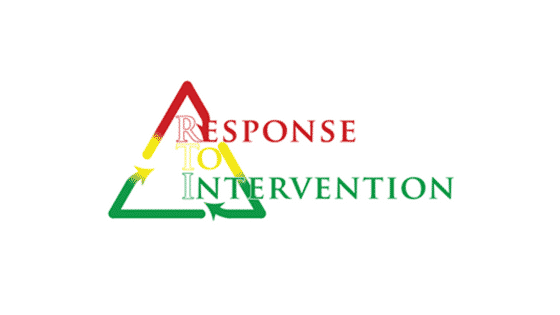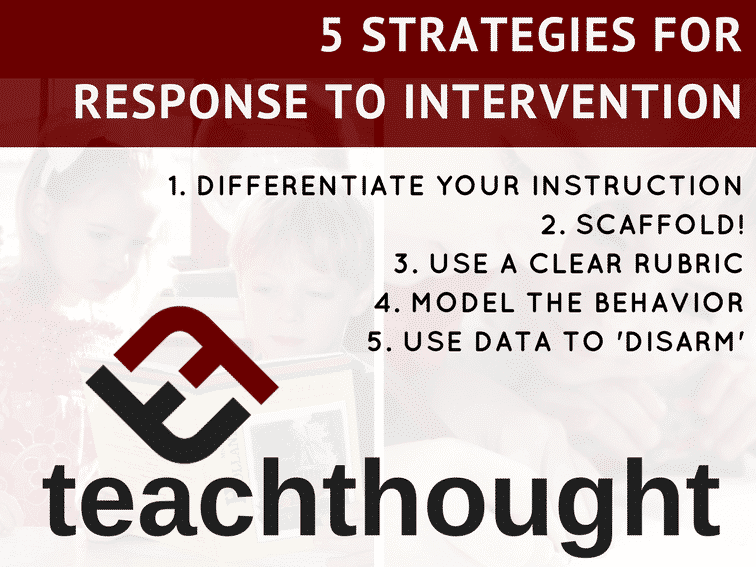
Do you agree that “no children are alike?” If you are a parent with children, you are one of the people who can attest to that. In a household, Mom and Dad treat, talk, and discipline each of their children distinctively, simply because a certain approach might effective for one but not for the other. It sounded easy, right? They are capable because they knew and understood the differences in their characters and personalities.
Schools are children’s second home. It’s incredible to witness how students excel, but it’s heartbreaking to see some who struggles. While their reasons for struggling varies, it’s important to point out how teachers or educators can help them out. There are a lot of frameworks or programs being implemented. For now, let’s take a look at Austin Buffum, EdD, and Mike Mattos statement, “Schools cannot ensure the success of every student unless they can effectively intervene when students struggle. Research and evidence in our field are conclusive—RTI is the best way to intervene.”
RTI focuses on early and continuous identification, assessment and assistance of students who have learning and behaviour needs. These are typically aimed at addressing trouble spots and building underdeveloped prerequisite skills to accelerate learning. RTI—also known as a multitiered system of support (MTSS)—is a systematic process that helps ensure all students receive the time and support needed to learn at high levels.
The RTI process begins with high-quality instruction and universal screening of all children in the general education classroom. Struggling learners are provided with interventions at increasing levels of intensity to accelerate their rate of learning. These services may be provided by a variety of personnel, including general education teachers, special educators, and specialists. RTI is designed for use when making decisions in both general education and special education, creating a well-integrated system of instruction and intervention guided by child outcome data.
ESSENTIAL COMPONENTS OF RTI IMPLEMENTATION
- High-quality, scientifically based classroom instruction. All students receive high-quality, research-based instruction in the general education classroom.
- Ongoing student assessment. Universal screening and progress monitoring provide information about a student’s learning rate and level of achievement, both individually and in comparison with the peer group. These data are then used when determining which students need closer monitoring or intervention. Throughout the RTI process, student progress is monitored frequently to examine student achievement and gauge the effectiveness of the curriculum. Decisions made regarding students’ instructional needs are based on multiple data points taken in context over time.
- Tiered instruction. A multi-tier approach is used to efficiently differentiate instruction for all students. The model incorporates increasing intensities of instruction offering specific, research-based interventions matched to student needs.
- Parent involvement. Schools implementing RTI provide parents information about their child’s progress, the instruction and interventions used, the staff who are delivering the instruction, and the academic or behavioral goals for their child.
There isn’t universal, thoroughly researched and widely practiced “model” of the RTI process. But most districts and schools follow these 3-tier Model that uses research-based academic and/or behavioral interventions:
Tier 1: High-Quality Instruction and Proactive Assessment
Within Tier 1, all students receive high-quality, scientifically based instruction provided by qualified personnel to ensure that their difficulties are not due to inadequate instruction. All students are screened on a periodic basis to establish an academic and behavioral baseline and to identify struggling learners who need additional support. Students identified as being “at risk” through universal screenings and/or results on state- or districtwide tests receive supplemental instruction during the school day in the regular classroom. The length of time for this step can vary, but it generally should not exceed 8 weeks. During that time, student progress is closely monitored using a validated screening system such as curriculum-based measurement.
Think of the first RTI tier as everyday teaching.
It’s consistently delivering differentiated and scientifically-based instruction. This helps ensure that student struggles aren’t a result of improper teaching methods.
If you don’t already use them, some popular practices include:
In the context of RTI, high-quality instruction also involves providing supplemental learning opportunities based on assessment results. At the end of this period, students showing significant progress are generally returned to the regular classroom program.
Teaching Strategies
- Watch for Impostor Syndrome
Proactively looking for students who feign understanding, filling their knowledge gaps, can prevent disappointing surprises when marking tests or assignments. You can spot imposter syndrome by regularly:
- Asking Students for Their Own Words — Instead of repeating concepts verbatim, ask students to explain specific ideas using their own words. This will not only help them process content, but reveal how well they understand it.
- Using Exit Tickets — Save 10 minutes at the end of class, allowing students to write about what they learned. They’ll prepare for tomorrow’s lesson, whereas you’ll see who’s grasping content.
- Give Only Two Marks for Informal Assessments
Just state if a student did or did not meet expectations.
Then, provide struggling students with a clear path to improve. For example, pair classmates who didn’t meet expectations with those who did, giving them a review and practice activity. When strugglers are confident they understand key concepts, encourage them to tell you. Provide a new assessment, allowing them to prove their competency.
- Have Private Mid-Unit Conversations
At the middle of each unit, run a fun classwide activity that doesn’t introduce key skills or concepts. This gives you a chance to pull each student away for a few minutes to:
- Review results
- Note trouble spots
- Receive input about questions and problems
In doing so, each student can gauge his or her own understanding. Plus, it helps you determine if certain issues are isolated or widespread, informing how you’ll deal with them.
- Switch Between Solo, Small- and Large-Group Learning
Differentiated instruction is a hallmark of RTI’s first tier. And an easy, yet effective, way to differentiate is by alternating between individual and group activities.
For example, running literature circles in small groups encourages students to shape and inform each other’s understandings of readings, helping auditory and participatory learners retain more information. On the other hand, solo reflection exercises may appeal to those who don’t gain as much from discussion as independent thinking.
- Assign Open-Ended Projects
Giving choices for projects is another differentiation strategy that fits into the first intervention tier.
Instead of assigning an inflexible project, provide a list of ideas. This allows students to choose one that lets them best demonstrate their knowledge. Be sure to include a rubric for each project, setting clear expectations.
By enticing and challenging students, this approach encourages them to:
- Work and learn at their own paces
- Process content in ways that appeal to them
- Showcase their knowledge and skill mastery as effectively as possible
Students not showing adequate progress are moved to Tier 2.
Tier 2: Targeted Intervention
Students not making adequate progress in the regular classroom in Tier 1 are provided with increasingly intensive instruction matched to their needs on the basis of levels of performance and rates of progress. Intensity varies across group size, frequency and duration of intervention, and level of training of the professionals providing instruction or intervention. These services and interventions are provided in small-group settings in addition to instruction in the general curriculum. In the early grades (kindergarten through 3rd grade), interventions are usually in the areas of reading and math. A longer period of time may be required for this tier, but it should generally not exceed a grading period.
This stage uses rigorous supplementary exercises and lessons targeted to a student’s specific needs.
Normally, you would deliver these exercises and lessons in small-group settings outside of core class time. This allows students with common issues to work together, contextualizing and reinforcing concepts while building prerequisite skills.
You can objectively identify candidates for targeted intervention through:
- Mid-Unit Evaluations: At the middle of each unit, deliver a surprise quiz or in-class task that covers all core skills and concepts you’ve covered thus far.
- Formal Evaluations: After marking tests and assignments, it’ll be clear who’s struggling. Your school may have specific criteria, but targeted intervention candidates are typically students who receive failing grades or come close.
After class or during recess, work with students who need help. Focused on clarifying lingering issues or building underdeveloped skills, provide exercises that require they work together and individually.
You should match targeted intervention to student needs by adjusting the:
- Length
- Frequency
- Group size
- Nature of the exercises
Teaching Strategies
- Set Measurable Goals
Setting clearly-defined objectives will define an explicit route to graduate from intervention.
Addressing a given student’s challenges and trouble spots, objectives should take the form of learning and behaviour goals.
Learning goals focus on the student understanding concepts and developing skills. For example, “I, student’s name, will complete 10 additional questions about fractions, as provided by my math teacher, each weeknight for the next two weeks.”
Behaviour goals require the student to concentrate and work efficiently. For example, “I, student’s name, will not interrupt any of my teachers while they’re speaking. Instead, I will raise my hand to ask questions.”
Notice how the goals are measureable? If the student interrupts a teacher even once or only completes nine questions each night, he or she doesn’t meet them.
To reinforce the importance of these goals, review progress at each targeted intervention session.
- Add a Twist to Mixed-Ability Groups
Grouping high performers with struggling classmates for in-class activities is common, but needs a twist as a second tier intervention strategy.
That’s because underperforming students sometimes don’t actively participate in these groups. Instead, they rely on group members.
Here’s the twist: Run activities that require students to write down their thoughts or findings, but give each student a different colour pen.
You’ll likely notice the struggling students don’t write down as much. If this is the case, tell them they’ll present their groups’ thoughts or findings to the class. This way, they must process the content to prepare.
- Use EdTech that Adjusts to Each Student
Some educational technologies use adaptive learning principles, detecting student trouble spots and helping them build skills to overcome them.
- Model Everything and Use Role-Plays
To supplement explanations, demonstrating proper practices will give struggling students clear examples and reference points.
After giving instructions, you could act out a:
- Partner conversation, reaching conclusions by asking each other questions
- Brief presentation about answers, modeling what students should say about their ideas and problem-solving processes
This strategy helps intervention students participate to the best of their abilities, enjoying the activity itself.
5. Preach Four-Step Problem Solving
One of the most popular resources is A Problem Solving Approach to Mathematics for Elementary School Teachers. The authors describe four steps you should encourage students to follow, which work for most subjects.
The steps are:
- Understanding the Problem — Students should rewrite it in their own words, noting helpful information it reveals and indicates a need for.
- Devising a Plan — Students should use information they gleaned to make notes, tables, diagrams, equations and anything else that creates a path to solving the problem.
- Carrying out the Plan — Students should follow this path, reviewing each step along the way and making changes as needed.
- Looking Back — Students should double-check each step after reaching their answers. Then, it’s best to look at the “big picture.” Does the solution make sense when applied to the original problem? Is there a different, logical way of reaching the same solution? If not, they should re-visit their approaches.
Students who continue to show too little progress at this level of intervention are then considered for more intensive interventions as part of Tier 3.
Tier 3: Intensive Intervention and Evaluation
At this level, students receive individualized, intensive interventions that target the students’ skill deficits.
Based on the student’s learning style and needs, as well as underdeveloped skills, third tier intervention sessions can include:
- Talking with the child about his or her specific issues, discussing strategies to overcome them
- Sharing positive and corrective feedback whenever possible
- Providing diverse media to help process content
- Revisiting lessons from past units or years
- Setting achievement plans and goals
- Modeling problem-solving steps
The educator who runs these sessions must record as much data as possible about the student’s improvement or lack thereof. Are prerequisite skills starting to meet standards? Are there jumps in in-class performance?
Students who do not achieve the desired level of progress in response to these targeted interventions are then referred for a comprehensive evaluation and considered for eligibility for special education services under the Individuals with Disabilities Education Improvement Act of 2004 (IDEA 2004). The data collected during Tiers 1, 2, and 3 are included and used to make the eligibility decision.
It should be noted that at any point in an RTI process, IDEA 2004 allows parents to request a formal evaluation to determine eligibility for special education. An RTI process cannot be used to deny or delay a formal evaluation for special education.
Teaching Strategies
- Gamify a Personal Learning Plan
Motivating students in the final RTI tier is typically a challenge in of itself. Gamifying learning plans can engage and incentivize them, empowering them to move back in the middle tier.
Consider gamification strategies such as:
- Adjusting Your Scoring System — Give traditional scores and experience points (XP) on tests and assignments, setting a goal for the student to reach a certain amount of XP per unit. For example, if a student scores 60% on a quiz, give him or her 6,000 XP. You can also award XP for completing extra assignments, participating in class or anything else that shows effort to learn.
- Using Stages — Call topics and units stages. These terms have clear connotations for you, but students may not see how they fit together. If they’re gamers, they’ll understand that reaching the next stage requires overcoming precursory challenges. Emphasize this by framing certain tasks as prerequisites to reach that next learning stage.
- Gather Data to Spot Trends
Use data at your disposal to pinpoint where and when a student’s issues arose.
In doing so, you can tailor intensive instruction that addresses specific needs.
Let’s say you determine that a student’s performance didn’t start to sink when he or she entered your classroom. Rather, it went downhill in the middle of last year’s math class. It’s now clear you must revisit that content, helping the student build skills taught in that class. You can then move onto this year’s topics.
Depending on school or district resources, you may not be tasked with delving into this information. But if you are, look at resources that contain student performance across:
- Past years
- Previous units
- Current classes
- Different subjects
Invariably, an effective RTI approach is rooted in such data.
- Consider Peer Teaching
Pairing struggling students with top-performers can yield benefits, according to peer teaching studies.
For example, “students generally identify more easily with peer helpers than with adult authority figures,” according to an influential study. This means they may be more willing to ask questions and for feedback. What’s more, an Ohio University pilot study determined that students who read and discuss story passages with peers recall more content and score higher on assessments.
Peer tutoring is a nuanced pedagogy in its own right, but easy-to-run activities include:
- Think-pair-share exercises, which were discussed in the section about second tier strategies
- Peer editing exercises, which rely on tutors giving targeted feedback about a tutee’s written work
- Jigsaw exercises, which involve dividing an ambitious task into subtopics and having a tutor-tutee pair research the same subtopic together
If you use this strategy, just be sure to teach tutors about giving help and feedback.
- Reverse the Standard Peer Teaching Model
Peer teaching strategies typically see high-performing students tutor struggling classmates, but occasionally reversing the roles can have advantages.
When at-risk students help others in a controlled environment, research from the National Association of Secondary School Principals shows their confidence and communication abilities improve. This, in turn, can help them through the RTI process.
You and your students can reap these benefits through reciprocal peer tutoring (RPT). This involves partners taking turns as the tutor, and:
- Guiding the tutee through the problem-solving process
- Giving the tutee praise and feedback while working through exercises
- Reviewing content together, asking each other questions and finding answers
If struggling students don’t rise to their new responsibilities, just revert to traditional peer teaching.
- Seek Help
You’re not alone. Each school and district has a different makeup, but you shouldn’t have to handle the intervention process yourself.
To ease the rigours of intensive instruction and evaluation, communicate with:
- Fellow teachers for insight about the students you’re helping
- Learning support specialists for tips and to share responsibilities
- Administrators and your principal to provide updates and access data, especially if it seems a student needs special education services and parent involvement is required
Source and Reference: https://www.understood.org/en/school-learning/special-services/rti/understanding-response-to-intervention
https://www.prodigygame.com/blog/rti-response-to-intervention/#definition
http://www.rtinetwork.org/learn/what/whatisrti
RTI Infographic
Source: https://www.educatorstechnology.com/2017/07/the-teachers-response-to-intervention.html

5 Strategies for Response to Intervention

Read the full article here: https://www.teachthought.com/pedagogy/5-strategies-response-intervention/
How is RTI different from special education?
Visit this link: https://www.specialeducationguide.com/pre-k-12/response-to-intervention/how-is-rti-different-from-special-education/
We are not affiliated with any organization mentioned in this article. But we admire their dedication to guide educators with very informative and helpful resources. We love to share this with you. And we have high hopes that we will be able to contribute to your teaching techniques and strategies. As the saying goes, “it always takes a village to shape the future of the younger generation.”



